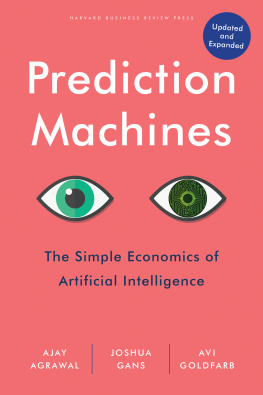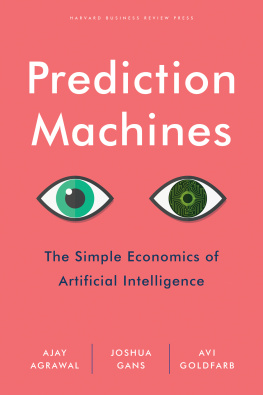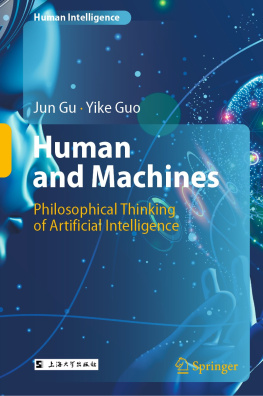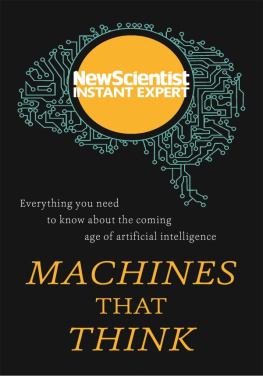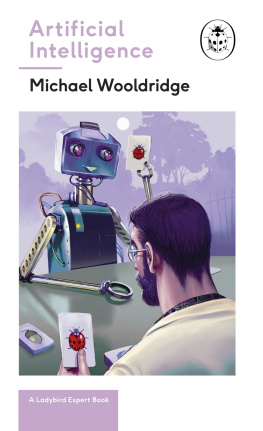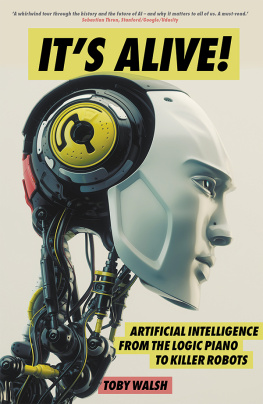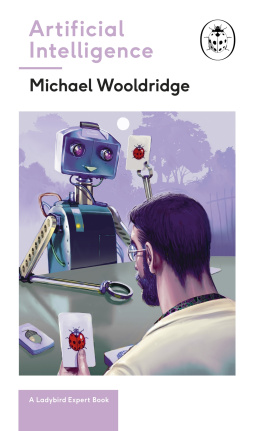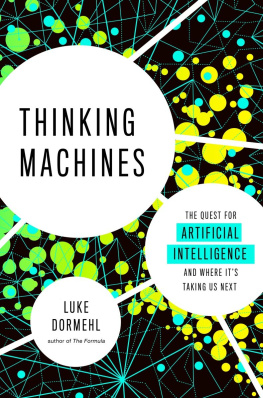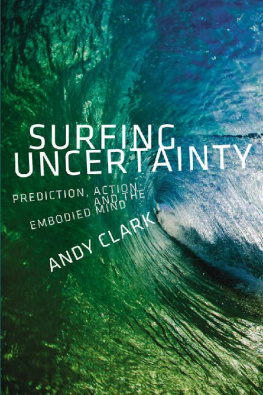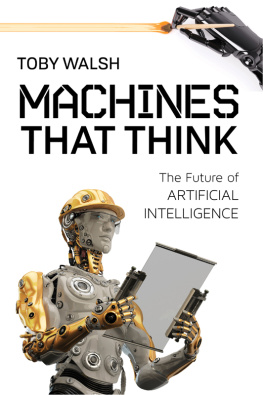HBR Press Quantity Sales Discounts
Harvard Business Review Press titles are available at significant quantity discounts when purchased in bulk for client gifts, sales promotions, and premiums. Special editions, including books with corporate logos, customized covers, and letters from the company or CEO printed in the front matter, as well as excerpts of existing books, can also be created in large quantities for special needs.
For details and discount information for both print and ebook formats, contact .
Copyright 2022 Ajay Agrawal, Joshua Gans, and Avi Goldfarb
All rights reserved
No part of this publication may be reproduced, stored in or introduced into a retrieval system, or transmitted, in any form, or by any means (electronic, mechanical, photocopying, recording, or otherwise), without the prior permission of the publisher. Requests for permission should be directed to , or mailed to Permissions, Harvard Business School Publishing, 60 Harvard Way, Boston, Massachusetts 02163.
First eBook Edition: Nov 2022
ISBN: 978-1-64782-467-9
eISBN: 978-1-64782-468-6
To our families, colleagues, students,
and startups who inspired us to think clearly
and deeply about artificial intelligence.
Contents
Preface to the Updated Edition
It has been five years since we were working on the first edition of Prediction Machines . That book was written just five years after University of Toronto researchers were able to demonstrate that deep learning methods could significantly outperform people in describing images. That moment marked the new and perhaps most significant advances in artificial intelligence to date. Over the course of the decade, AI has moved from nowhere to all over the place. We can see many of these advancessuch as how our phones can recognize our faces even with glasses or masks on. Others we do not see, such as the use of AI to more easily assess the quality of goods shipped on international supply chains. Now is a good opportunity to revise our best-selling book to ensure it is keeping up with the times.
Our perspective in analyzing AI and its impact for businesses comes from economics. As economists, we strip away the fanfare and try to reduce exciting technologies to their less exciting essence. We showed that these new advances in AI were, in one sense, just an advance in the statistics of prediction. But they took previous statistical methods to another plane. In reducing the cost of predicting things, they found applications where prediction was already used (e.g., the predictions of financial institutions) but also where people didnt realize prediction could be used (e.g., in image classification or self-driving vehicles). The past five years have only reinforced the usefulness of the careful application of economics for businesses.
We have now had the benefit of seeing many businesses take the tools we provide here and develop new applications for AI prediction. But we have also gained new insight into some of the associated challenges. Hence, we have added two new chapters to the book that delve deeper. One describes how prediction is a substitute for other ways of managing risk (like insurance), and another shows that the stakes associated with the decision really matter when you are thinking of relying on prediction machines that are not perfect (they are just predictions after all). We believe these will help you carefully sort out the right entry points for AI in your business and make your next decade a profitable and innovative one.
We had another new insight since writing Prediction Machines . Not only do advances in AI lower the cost of predictions, but they decouple prediction and judgmenttwo primary inputs to decision-making. This decoupling will become the cornerstone of new system-level solutions. Lower-cost predictions enable point solutions that impact a single decision or action, whereas decoupling enables solutions that impact systems of related decisions. This insight is like a Russian nesting doll. Each time we unpacked the main idea, we found another one inside. So, we wrote a new book as a companion to this one. In Prediction Machines , we explain the simple economics of AI and describe how the technology is used for point solutions. In Power & Prediction , our new book, we explain the economics of interrelated decision-making and describe how to use the technology for system-level solutions. System solutions are often difficult for incumbents to implement because they shift decision rights, and thus power, from some people or companies to others. As a result, there is resistance to this type of change. To date, most investment in AI has focused on point solutions. We anticipate that will changeand thus AI will become more disruptive. So, buckle up.
Ajay Agrawal, Joshua Gans, and Avi Goldfarb, 2022
Acknowledgments
We express our thanks to the people who contributed to this book with their time, ideas, and patience. In particular, we thank Abe Heifets of Atomwise, Liran Belanzon of BenchSci, Alex Shevchenko of Grammarly, Marc Ossip, and Ben Edelman for the time they spent with us in interviews, as well as Kevin Bryan for his comments on the overall manuscript. Also, we thank our colleagues for discussions and feedback, including Nick Adams, Umair Akeel, Susan Athey, Naresh Bangia, Nick Beim, Dennis Bennie, James Bergstra, Dror Berman, Vincent Brub, Jim Bessen, Scott Bonham, Erik Brynjolfsson, Andy Burgess, Elizabeth Caley, Peter Carrescia, Iain Cockburn, Christian Catalini, James Cham, Nicolas Chapados, Tyson Clark, Paul Cubbon, Zavain Dar, Sally Daub, Dan Debow, Ron Dembo, Helene Desmarais, JP Dube, Candice Faktor, Haig Farris, Chen Fong, Ash Fontana, John Francis, April Franco, Suzanne Gildert, Anindya Ghose, Ron Glozman, Ben Goertzel, Shane Greenstein, Kanu Gulati, John Harris, Deepak Hegde, Rebecca Henderson, Geoff Hinton, Tim Hodgson, Michael Hyatt, Richard Hyatt, Ben Jones, Chad Jones, Steve Jurvetson, Satish Kanwar, Danny Kahneman, John Kelleher, Moe Kermani, Vinod Khosla, Karin Klein, Darrell Kopke, Johann Koss, Katya Kudashkina, Michael Kuhlmann, Tony Lacavera, Allen Lau, Eva Lau, Yann LeCun, Mara Lederman, Lisha Li, Ted Livingston, Jevon MacDonald, Rupam Mahmood, Chris Matys, Kristina McElheran, John McHale, Sanjog Misra, Matt Mitchell, Sanjay Mittal, Ash Munshi, Michael Murchison, Ken Nickerson, Olivia Norton, Alex Oettl, David Ossip, Barney Pell, Andrea Prat, Tomi Poutanen, Marzio Pozzuoli, Lally Rementilla, Geordie Rose, Maryanna Saenko, Russ Salakhutdinov, Reza Satchu, Michael Serbinis, Ashmeet Sidana, Micah Siegel, Dilip Soman, John Stackhouse, Scott Stern, Ted Sum, Rich Sutton, Steve Tadelis, Shahram Tafazoli, Graham Taylor, Florenta Teodoridis, Richard Titus, Dan Trefler, Catherine Tucker, William Tunstall-Pedoe, Stephan Uhrenbacher, Cliff van der Linden, Miguel Villas-Boas, Neil Wainwright, Boris Wertz, Dan Wilson, Peter Wittek, Alexander Wong, Shelley Zhuang, and Shivon Zilis. We also thank Carl Shapiro and Hal Varian for their book Information Rules , which served as a source of inspiration for our project. The Creative Destruction Lab and Rotman School staffs have been fantastic, particularly Steve Arenburg, Dawn Bloomfield, Rachel Harris, Jennifer Hildebrandt, Anne Hilton, Justyna Jonca, Aidan Kehoe, Khalid Kurji, Mary Lyne, Ken McGuffin, Shray Mehra, Daniel Mulet, Jennifer OHare, Gregory Ray, Amir Sariri, Sonia Sennik, Kristjan Sigurdson, Pearl Sullivan, Evelyn Thomasos, and the rest of the Lab team and Rotman staff. We thank our dean, Tiff Macklem, for his enthusiastic support of our work on AI at the Creative Destruction Lab and throughout the Rotman School. Thanks also to the leadership and staff at The Next 36 and The Next AI. We also thank Walter Frick and Tim Sullivan for stellar editing, as well as our agent, Jim Levine. Many of the ideas in the book build on research supported by the Social Sciences and Humanities Research Council of Canada, the Vector Institute, the Canadian Institute for Advanced Research under the leadership of Alan Bernstein and Rebecca Finlay, and the Sloan Foundation with Danny Goroffs support under the Economics of Digitization grant, managed by Shane Greenstein, Scott Stern, and Josh Lerner. We are grateful for their support. We also thank Jim Poterba for his support of our conference on the economics of AI through the National Bureau of Economic Research. Finally, we thank our families for their patience and contributions during this process: Gina, Amelia, Andreas, Natalie, Belanna, Ariel, Annika, Rachel, Anna, Sam, and Ben.

